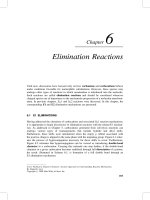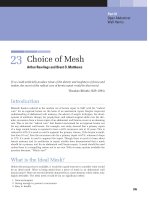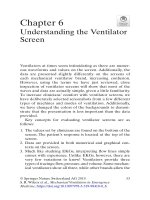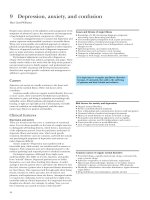Ebook Paediatric nursing in Australia (2/E): Part 1
Bạn đang xem bản rút gọn của tài liệu. Xem và tải ngay bản đầy đủ của tài liệu tại đây (3.57 MB, 279 trang )
PA E D I AT R I C N U R S I N G I N A U S T R A L I A
Principles for Practice
Second edition
The second edition of Paediatric Nursing in Australia: Principles for
Practice brings the important care of the child and young person to life, by
equipping students with essential knowledge and skills to become
informed and capable partners in the nursing care of children, young
people and their families across a variety of clinical and community
settings.
The text develops students’ critical thinking and problem-solving skills
by exploring contemporary issues impacting on the health of children,
young people and their families.
This new edition features the latest research and case studies, coupled
with reflection points and learning activities in each chapter. Further
resources, including links to video and web content, multiple-choice
questions and critical-thinking problems, are available on the updated
instructor
companion
website
at
www.cambridge.edu.au/academic/paediatricnursing2e.
Written by a team of experienced nurses within the field, Paediatric
Nursing in Australia is grounded in current care delivery and is an
essential resource in preparing future nurses for practice in paediatric
settings throughout Australia
Jennifer Fraser is an Associate Professor of Sydney Nursing School at
the University of Sydney.
Donna Waters is a Professor in and Dean of Sydney Nursing School at
the University of Sydney.
Elizabeth Forster is a Senior Lecturer in the Faculty of Health,
Engineering and Sciences at the University of Southern Queensland.
Nicola Brown works in the Professional Practice and Innovation Centre at
Tresillian Family Care Centres.
PAEDIATRIC NURSING IN
AUSTRALIA
Principles for Practice
Second edition
Jennifer Fraser
Donna Waters
Elizabeth Forster
Nicola Brown
University Printing House, Cambridge CB2 8BS, United Kingdom
One Liberty Plaza, 20th Floor, New York, NY 10006, USA
477 Williamstown Road, Port Melbourne, VIC 3207, Australia
4843/24, 2nd Floor, Ansari Road, Daryaganj, Delhi – 110002, India
79 Anson Road, #06-04/06, Singapore 079906
Cambridge University Press is part of the University of Cambridge.
It furthers the University’s mission by disseminating knowledge in the pursuit of
education, learning and research at the highest international levels of excellence
www.cambridge.org
Information on this title: www.cambridge.org/9781316642221
© Cambridge University Press 2014, 2017
This publication is copyright. Subject to statutory exception and to the provisions of
relevant collective licensing agreements, no reproduction of any part may take place
without the written permission of Cambridge University Press.
First published 2014
Second edition 2017
Cover designed by eggplant communications
Typeset by Integra Software Services Pvt. Ltd
Printed in Singapore by Markono Print Media Pte Ltd, April 2017
A catalogue record for this publication is available from the British Library
A Cataloguing-in-Publication entry is available from the catalogue of the National
Library of Australia at www.nla.gov.au
ISBN 978-1-316-64222-1 Paperback
Additional resources for this publication at
www.cambridge.edu.au/academic/paediatricnursing2e
Reproduction and communication for educational purposes
The Australian Copyright Act 1968 (the Act) allows a maximum of one chapter or 10% of
the pages of this work, whichever is the greater, to be reproduced and/or communicated
by any educational institution for its educational purposes provided that the educational
institution (or the body that administers it) has given a remuneration notice to Copyright
Agency Limited (CAL) under the Act.
For details of the CAL licence for educational institutions contact:
Copyright Agency Limited
Level 15, 233 Castlereagh Street
Sydney NSW 2000
Telephone: (02) 9394 7600
Facsimile: (02) 9394 7601
E-mail:
Reproduction and communication for other purposes
Except as permitted under the Act (for example a fair dealing for the purposes of study,
research, criticism or review) no part of this publication may be reproduced, stored in a
retrieval system, communicated or transmitted in any form or by any means without prior
written permission. All inquiries should be made to the publisher at the address above.
Cambridge University Press has no responsibility for the persistence or accuracy of URLs for
external or third-party internet websites referred to in this publication and does not guarantee
that any content on such websites is, or will remain, accurate or appropriate.
Cover image: Beach, by Jane Reiseger, is part of the Victorian flora and fauna theme
displayed at The Royal Children’s Hospital Melbourne, Victoria, Australia.
Every effort has been made in preparing this book to provide accurate and up-to-date
information that is in accord with accepted standards and practice at the time of
publication. Although case histories are drawn from actual cases, every effort has been
made to disguise the identities of the individuals involved. Nevertheless, the authors,
editors and publishers can make no warranties that the information contained herein is
totally free from error, not least because clinical standards are constantly changing
through research and regulation. The authors, editors and publishers therefore disclaim all
liability for direct or consequential damages resulting from the use of material contained
in this book. Readers are strongly advised to pay careful attention to information provided
by the manufacturer of any drugs or equipment that they plan to use.
Contents
List of contributors
Preface
1 Australia’s children and young people
Donna Waters
Introduction
Australia’s children and young people
The health of Australia’s children and young people
Emerging health priorities
Applying new knowledge to practice
Summary
Learning activities
Further reading
References
2 Child rights in Australia
Jennifer Fraser and Helen Stasa
Introduction
International legislation
Australian legislation
Practice implications
Priorities in relation to children’s rights and child-protection
legislation
Summary
Learning activities
Further reading
References
3 Family and community
Ibi Patane and Elizabeth Forster
Introduction
Families in contemporary Australian society
The Family Partnership Model
Family-centred care
Family assessment
Aboriginal and Torres Strait Islander family considerations
Cultural safety
Summary
Learning activities
Further reading
References
4 Psychosocial development and response to illness
Jennifer Fraser and Robyn Rosina
Introduction
The psychosocial development of children and young people
experiencing disruptions to health
Trust versus mistrust: Infancy (first year of life) and the sick
infant
Autonomy versus shame and doubt: Infancy (second year of
life) and the sick toddler
Initiative versus guilt: Early childhood – the preschool years
(3–5 years)
Industry versus inferiority: Middle and late childhood (infants
and primary school – 6 years to puberty)
Identity versus identity confusion: Adolescence (10–20 years)
Intimacy versus isolation: Early adulthood (twenties and
thirties) and the sick young adult
Summary
Learning activities
Further reading
References
5 Research in the paediatric setting
Donna Waters
Introduction
What is research?
What is evidence-based practice?
Researching with children and young people
Human research and ethics
Core principles of research ethics
Justice in paediatric research
Research monitoring and participation
Applying new knowledge to practice
Summary
Learning activity
Further reading
Websites
References
6 Recognising and responding to the sick child
Elizabeth Forster and Loretta Scaini-Clarke
Introduction
Structured assessment of the paediatric patient
The Paediatric Assessment Triangle
The Primary Assessment Framework
Paediatric neurological assessment tools
Responding to the sick child
Paediatric basic and advanced life support
Parental presence during resuscitation
Summary
Learning activity
Further reading
References
7 Mental health and illness in childhood and adolescence
Jennifer Fraser, Lindsay Smith and Julia Taylor
Introduction
Mental health problems and mental disorders
What mental disorders affect Australian children?
Attention Deficit Hyperactivity Disorder
Autism Spectrum Disorder
Externalising disorders: Conduct disorders
Risk and protective factors
Internalising disorders: Anxiety and depression
Promoting mental health in children and young people
Eating disorders
Ten practical strategies for promoting child and adolescent
mental health
Summary
Learning activity
Further reading
References
8 Evidence-based nursing assessments and interventions: The
acutely ill child
Nicola Brown and Robyn Galway
Introduction
Key nursing considerations for the acutely unwell child
Dehydration
Intravenous therapy
Oxygen therapy
Pain assessment
Pain management
Common acute illnesses in childhood
Rashes in childhood
Meningococcal disease
Parvovirus (fifth disease)
Atopic dermatitis (eczema)
Hand, foot and mouth disease
Anaphylaxis
Infantile hypertrophic pyloric stenosis
Summary
Learning activities
Further reading
References
9 Evidence-based nursing assessments and interventions: The
acutely ill young person
Nicola Brown and Nerralie Shaw
Introduction
Key issues for young people during hospitalisation
Injuries
Abdominal pain
Pre-operative care
Post-operative care
Alcohol poisoning
Summary
Learning activities
Further reading
References
10 Evidence-based nursing assessments and interventions: The
child and young person with a chronic illness
Donna Waters and Helen Stasa
Introduction
Chronic conditions
Congenital, chromosomal and genetic disorders
Transition to adult care
Summary
Learning activities
Further reading
References
11 Evidence-based care of children with complex medical needs
Nicola Brown
Introduction
Types of conditions associated with complex medical needs
Families and children with complex medical needs
Nursing assessment and interventions
Summary
Learning activity
Further reading
References
12 End-of-life and palliative care in Australian paediatric care
settings
Elizabeth Forster
Introduction
Pain
Fatigue
Dyspnoea
Gastrointestinal disturbances
Anxiety
Communication with children and adolescents
Communication and the family in paediatric end-of-life care
Summary
Learning activities
Further reading
References
Index
Contributors
Editors
Nicola Brown is the Nurse Manager at the Professional Practice and
Innovation Centre at Tresillian Family Care Centres in New South
Wales.
Elizabeth Forster is a Registered Nurse and Senior Lecturer in the
Faculty of Health, Engineering and Sciences at the University of
Southern Queensland.
Jennifer Fraser is a Registered Nurse and Associate Professor in
Nursing at the University of Sydney.
Donna Waters is a Registered Nurse and Professor in and Dean of
the Faculty of Nursing and Midwifery (Sydney Nursing School) at the
University of Sydney
Chapter authors
Robyn Galway is a Registered Nurse with more than twenty years’
experience in the tertiary paediatric setting.
Ibi Patane is a Lecturer and Paediatric Subject Area Coordinator at
QUT, and is involved in paediatric education for both postgraduate
and undergraduate nursing students. She is a nationally accredited
Paediatric Specialist Nurse and has vast clinical experience in the
acute paediatric setting.
Robyn Rosina is an academic within the School of Nursing and
Midwifery at the University of Newcastle.
Loretta Scaini-Clarke is a Paediatric Intensive Care Nurse Educator,
and has over 30 years’ experience as a critical care nurse. She is a
faculty member in a number of paediatric training courses, and was
instrumental in the development of PICU education programs for
Queensland Health.
Nerralie Shaw is a Registered Nurse working in an education role in
the Emergency Department at Sydney Children’s Hospital.
Lindsay Smith is a Lecturer in the School of Health Sciences at the
University of Tasmania. He developed the Australian Family
Strengths Nursing Assessment (AFSNA).
Helen Stasa is a former policy officer at the Royal Australasian
College of Physicians.
Julia Taylor is a Registered Nurse and Clinical Lecturer at the
University of Tasmania.
Preface
We hope that you find this second edition of Paediatric Nursing in
Australia: Principles for Practice useful as a contemporary primary
resource for pre-registration students of nursing as well as new graduates
practising in Australian paediatric settings. The second edition maintains a
strong Australian focus. We have incorporated feedback from students,
educators and our academic colleagues to improve each chapter and hope
you are pleased with the result. We are most grateful to Cambridge
University Press for offering to support us to publish the second edition.
The second edition of this text first sets the context within which
student nurses can expect to practise paediatric nursing in Australia. It
presents the profile of child health, illness and injury within Australian
communities and includes details of national health trends for children and
young people in Australia, in comparison with international trends.
Emphasis is given to evidence-based paediatric nursing assessment,
nursing care and nursing interventions in paediatric settings. This includes
acute care, complex care, care of the child with a chronic illness and
childhood mental health care.
We are most appreciative of the superb effort of our contributing
authors in sharing their expertise in this second edition. Sincere thanks to
Robyn Galway, Ibi Patane, Robyn Rosina, Loretta Scaini, Lindsay Smith,
Helen Stasa, Nerralie Shaw and Julia Taylor once again for their time and
effort in creating this second edition of Paediatric Nursing in Australia:
Principles for Practice.
Jennifer Fraser, Donna Waters, Elizabeth Forster and Nikki
Brown
1
Australia’s children and young
people
◈
Donna Waters
Learning objectives
In this chapter you will:
Be introduced to the demographic profile of Australia’s children
and young people and the measures used to monitor their health
and wellbeing
Gain a sense of the current health and wellbeing of children and
young people living in Australia
Consider existing and emerging threats to the health and
wellbeing of Australia’s children and young people within a
global context
Reflect on your knowledge of the health and wellbeing of
Australia’s children and young people, and how you might use
this knowledge in your work as a nurse
Introduction
This chapter examines the health of children and young people growing up
in Australia. The aim is to consider children and young people in a more
global context and as the future population of Australia. We will look at
population characteristics, challenges to healthy growth and development,
and emerging health and social trends. We will also define and describe
some of the measures (or indicators) of children and young people’s health
referred to throughout the text.
The future role of the paediatric nurse is not only shaped by emerging
physical threats such as childhood obesity, injury and chronic illness, but
also by behavioural, developmental and mental threats resulting from the
rapid social and environmental change affecting children and young
people all over the world. We invite you to consider the idea that the
health and welfare of the children and young people of Australia are as
much determined by the context of the past and present as they will be by
the context of the future.
As you read more widely about the health and wellbeing of children
and young people, you will become aware of many different definitions
and descriptors for age groups within this population. The Australian
Bureau of Statistics (ABS), for example, defines children as those aged
under 15 years of age and young people as being 15–24 years of age. In
Australia, legal adulthood is established at 18 years of age, and the ABS
defines young adults as being in the age range 18–34 years.
In this text, infants, children, adolescents and young people
approaching adulthood (up to 18 years of age) collectively constitute the
group defined as Australia’s children and young people. We will use the
age range 0–4 years to describe the period of infancy and early
childhood, 5–12 years as childhood and 13–18 years as adolescence.
Case study 1.1
Australia – the ‘lucky country’?
According to the major indices of a successful society, Australia
ranks as one of the best places to live in the world. The population
of this somewhat isolated continent – the sixth-largest land-mass in
the world – enjoys health, housing, nutrition, income, civil rights
and a strongly performing economy. A comparatively small total
population of 24 million people clusters towards the moderate
climates and highly urbanised areas of the east coast, with more
than 11 million Australians settled in the largest cities of
Melbourne, Sydney and Brisbane.
Aboriginal Australians inhabited the continent for tens of
thousands of years before colonisation by the British in 1788. After
centuries of discrimination and exploitation, Aboriginal and Torres
Strait Islander peoples now make up less than 3 per cent of
Australia’s population. While the government formally apologised
to Aboriginal Australians in 2008 for years of discrimination and
injustice, Aboriginal Australians continue to experience high rates
of illness, unemployment and imprisonment.
Australia’s current political orientation is towards Asia, but a
rich and complex immigration history has woven itself into the
fabric of a country that is now home to people from over 140
countries. With the gradual dismantling of the White Australia
policy in the years following World War II, the 1950s saw the
arrival of mainly European migrants seeking to build a better life
for their families, especially their children. Around 72 per cent of
Australia’s population was born in Australia. In 2012, the majority
of permanent migrants to Australia were from the United
Kingdom, the People’s Republic of China, India, the Philippines
and Vietnam.
Australia’s children and young people
Indicator measurement
Before we take a look at the many reports published about the current and
future state of the health of children and young people in Australia, it is
useful to provide a quick update on some demographic and statistical
terminology. The use of a common international language for the
measurement and tracking of health indicators allows for the comparison
of global data over time and between countries. In Australia, government
agencies routinely collect data on the health and wellbeing of the
population. The best known of these agencies are the ABS and the
Australian Institute of Health and Welfare (AIHW). In addition to
conducting the national Census of Population and Housing every five
years since 1911, the ABS collects a wide range of demographic and
statistical data to inform future planning by the Commonwealth
government.
Advances in technology and data capture have enabled health data
agencies to significantly increase the transparency and sophistication of
data recording, and to improve accessibility to organised and standardised
sets of health indicators. It is now common to find companion documents
or large appendices to indicator reports outlining the rationale for the
choice of a unit of measurement (for example, average over one year);
definitions of numerators and denominators for rate-based calculations;
and reporting of centiles, summary statistics (mean and median) and
measures of spread or variation (standard deviation) to facilitate
comparison with other data. While rate-based statistics are mostly used to
describe population-level data, various clinical indicators are also used in
Australian hospitals for measuring trends and variations in the quality and
safety of health care (ACHS 2015).
The routine measurement of standardised internationally recognised
indicators of health and wellbeing over time is extremely useful because
health indicators can:
offer a snapshot of the health of a community or group at a single
point in time
enable long-term tracking of the health of specific populations or
groups
monitor upward and/or downward movements or trends over time
measure the impact of specific health interventions such as healthpromotion strategies
use past information to predict (or model) what might happen in
the future
facilitate international comparisons (benchmarking).
In addition to the routine collection of Australian health data, health
indicators also enable us to compare the health and wellbeing of Australian
children and young people with those of other children growing up in
countries similar to ours. For example, it is very common for government
reports to compare statistics for Australia against those of countries who
share membership of the Organisation for Economic Cooperation and
Development (OECD). It is of note, for example, that for data collected in
2011, the OECD Family Database (OECD, 2015: 2) names Australia
among the four OECD countries with the highest proportions (14–18 per
cent) of children living in jobless families.
Table 1.1 defines indicator measures for some of the 19 common
health priority areas identified as key national indicators (or headline
indicators) for describing the health, development, wellbeing and welfare
of children and young people in Australia.
Table 1.1 Example of key national health indicators for children and
young people
Outcome
Mortality
Morbidity
Indicator
How it is measured (per
year)
Infant mortality: Number
of deaths of infants less
than 1 year of age in a
given year
Rate per 1000 live births
Sudden Infant Death
Syndrome (SIDS)
Rate per 100 000 live
births
Death rate for children
1–14 years
Rate per 100 000 children
Proportion of all children
(0–14 years) diagnosed
with asthma
Percentage of all children
with asthma 0–14 years









